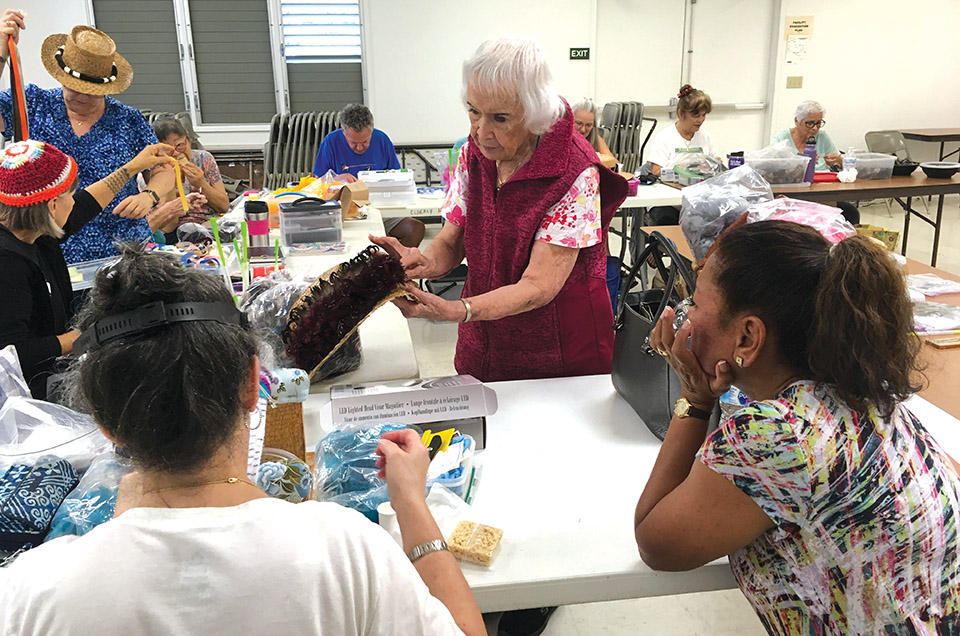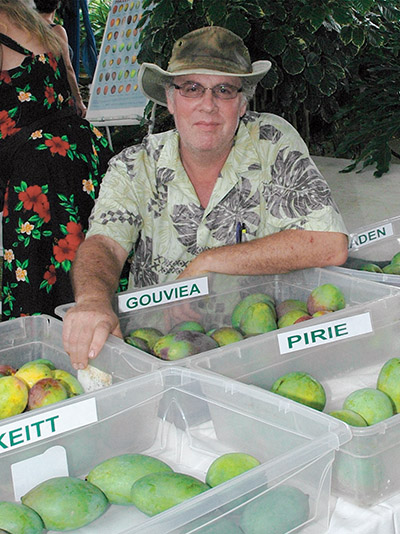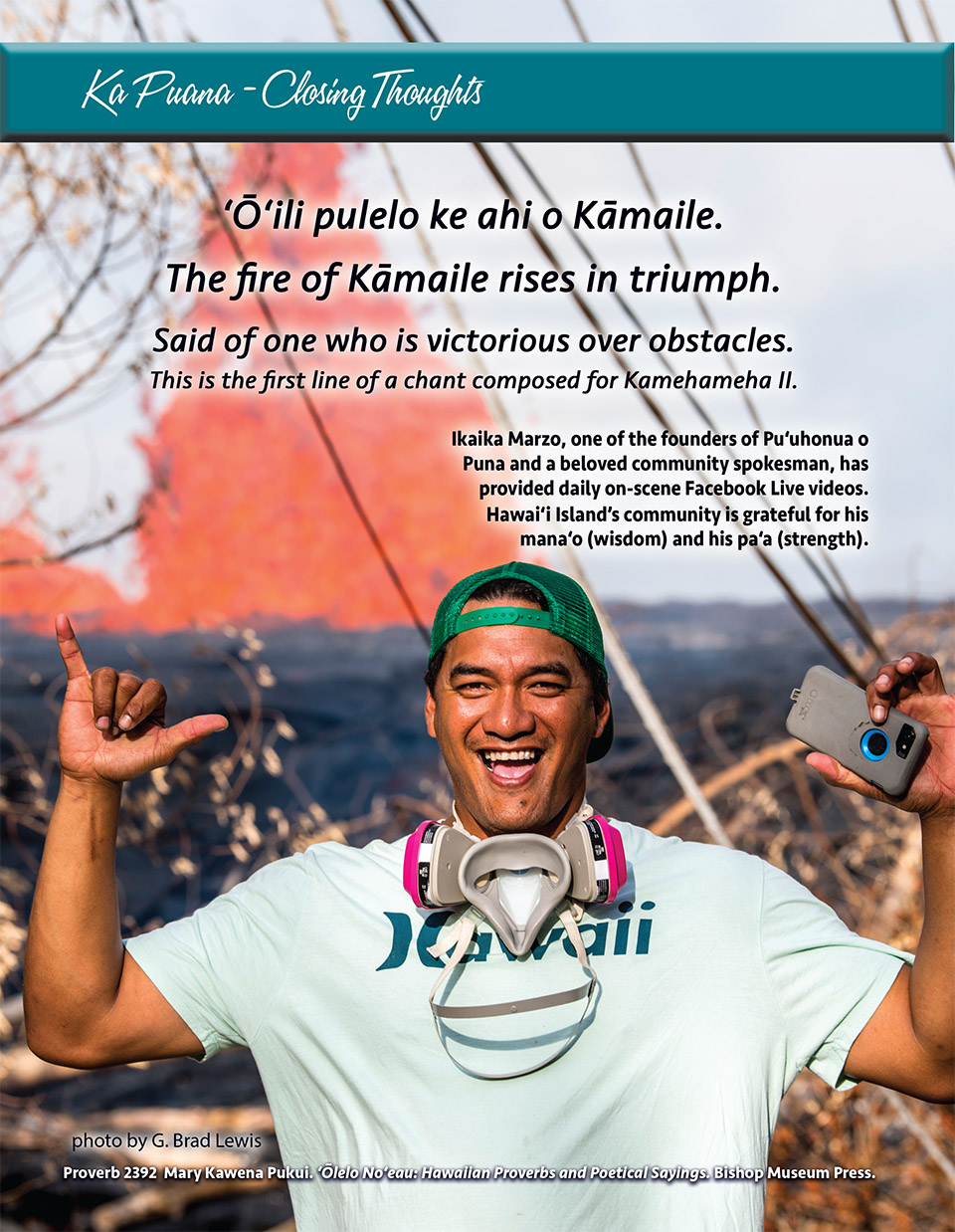
Art Meets Nature at Niaulani Sculpture Garden
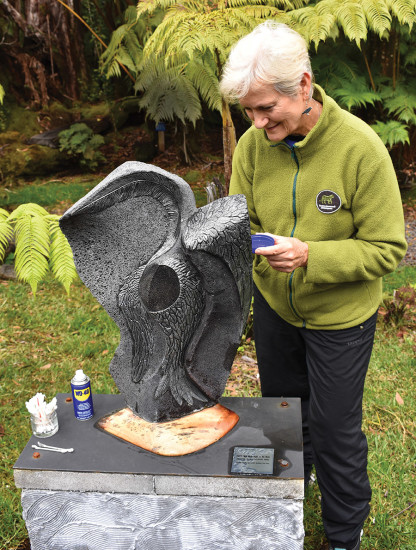
By Alan D. McNarie
It’s a drizzly morning in Volcano Village. Elizabeth Miller is kneeling in the new sculpture garden out behind the main building of Volcano Art Center’s Niaulani campus. She’s taking advantage of a small break in the weather to apply WD-40 penetrating oil to the metal surfaces of Pueo’s Flight Made Bright by the Moon, the sculpture that she and Jonathan Sudler created for Niaulani’s new sculpture garden. The WD-40 is needed because Kīlauea’s Halema‘uma‘u crater is erupting just a mile or so away.
The rain that so frequently falls in the garden contains sulfuric acid from the volcanic steam cloud. Elizabeth’s sculpture, inspired by the pueo, the native owl, is made from basalt and aluminum. Elizabeth needed a way to protect its exquisitely detailed aluminum feathers from corroding away, and a coat of lacquer or plastic would obscure those details. She discovered that a super-thin coat of WD-40 can keep out the acid rain—but it has to be applied frequently. Welcome to the challenges of creating the island’s first and only outdoor sculpture garden.
Time and the Elements
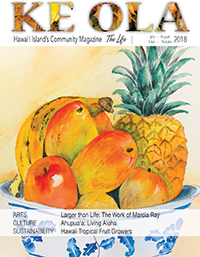
Some of the garden’s sculptors are taking a different approach, though, letting their creations weather and change naturally. “That’s why sculpture gardens are important, because it shows the interaction of the art with nature, and the artist can let go and let nature interact with their piece,” believes Julie Williams, the garden’s founder. “In a museum, everything is so hermetically sealed, but in a sculpture garden, the art pieces change over time—especially in such a dynamic place as Volcano.”
It is up to the sculptors how much and in what way their art piece interacts with nature—and also up to their materials. Glen Yamanoha, for instance, is thinking about touching up the flaking scarlet paint of I‘iwi, his giant steel outline of the iconic Hawaiian forest bird, which perches in a clump of yellow mau hau hele (a native Hawaiian hibiscus).
On the other hand, Ethan Froney’s Kūlia I Ka Nu‘u, which resembles an ancient Hawaiian petroglyph rendered in 3D out of forged iron, already sports a shaggy orange coat of rust that he knew would happen.
Other sculptures, made from terrazzo or basalt, have hardly changed at all, though a little algae may be starting to grow on their surfaces.
A Garden of Learning
The sculpture garden opened in September 2017 just as Julie’s daughter was due to give birth; she laughingly recalls the race to get her brainchild into the world before her grandchild arrived. She had been dreaming of the sculpture garden for years. “I’m not an artist, but I love art, and I so admire people that can interpret nature,” she says.
Julie, who also coordinates the art center’s volunteers, is a retired botanist and educator who for years ran a Department of Education facility in Volcano, where children from across the state came to learn about Hawai‘i’s volcanoes and rainforests. In many ways, the sculpture garden is an extension of that same mission.
Most of the artworks currently on exhibit were inspired by their natural surroundings. Take, for instance, Henry Bianchini’s New Idea in Flow of Nature, which somehow manages to embody an obelisk, a human figure and the lava flow at the same time. “Lava finds its natural flow as it moves across the new world,” Henry writes of the piece. “Man’s presence is always near and yet he cannot interfere or change this natural flow. Man is humbled by this power and yet stimulated. New ideas arise.”
Julie herself oversaw the planting and labeling of dozens of native plants among the sculptures, often helped by children from Volcano School of Arts and Sciences, the charter school that resides in the building that once housed the Williams’ education center. “The students have come here, had drawing sessions here, learned the native plants and helped maintain the garden,” she says.

Birthing the Garden
When the idea finally looked ready to become reality, Julie recruited Elizabeth, one of many talented artists who had put down roots in Volcano, inspired by the lava and the rainforest. “Julie wanted me to be her right-hand person. I know a lot of the sculptors,” recalls Elizabeth. “I understand how sculptors think. I worked with Julie on understanding timelines. For instance, it’s a longer process to create a sculpture and there’s more engineering involved. Every sculptor has to be an engineer.”
Julie got a start-up grant from the Atherton Foundation, and with Elizabeth’s help, started planning the garden. Like most art galleries, the sculpture garden will host rotating exhibitions, but instead of changing monthly, each exhibition will stay for about a year.
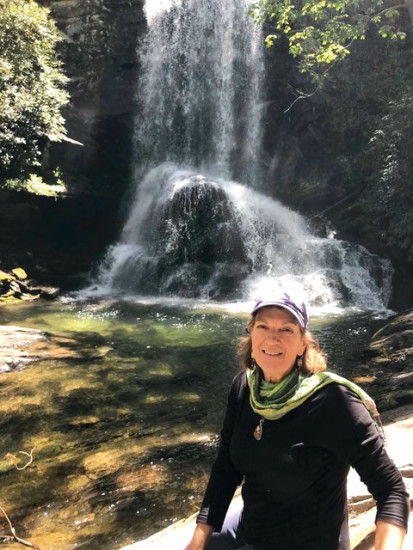
For the first exhibition, the center decided to invite six of the best sculptors they knew on the island: Elizabeth Miller, Jonathan Sudler, Glen Yamanoha, Henry Bianchini, Lonny Tamono, and Randall Shiroma. In addition to supplying the artwork, they would all contribute to the garden’s design and help with the year-long process of creating it, aided by community volunteers, school kids and 30 visiting Alaska National Guardsmen who volunteered their services for a day.
Also contributing was the ghost of another artist. Sheltered beneath a huge koa tree at the back of the garden is a mysterious, monk-like wooden figure by the late Randy Takake, who lived and worked for years in Volcano. The statue is called Guardian. “Randy’s mother gave us that sculpture on permanent loan,” says Elizabeth. “It was always in front of his studio. Randy loved all the arts—not just sculpture, but music and dance and writing, too. So we see the sculpture as a guardian of all the arts.”
Glen Yamanoha, in addition to being a talented artist, knows how to operate heavy earth-moving equipment. He recruited his friend, landscape architect David Tamura, to design the space. “David used a koa tree at the back for a focal point,” says Julie. “He wanted there to be some topography and some hidden places to explore.” David laid out a plan for contouring the garden with small, vegetated hillocks and a figure eight of winding paths to show off the sculptures and plants. Under his direction, large stones dug up during the landscaping were strategically placed back along the paths, becoming another design element. “He placed rocks keeping this Japanese sensibility—kind of asymmetrical and sparse,” says Glen. “I feel like he [David] was one of the sculptors, too.”
“Glen and his backhoe brought David’s vision to life by sculpting the land itself,” says Elizabeth. “Julie was the botanist sculptor.”
Living Sculptures
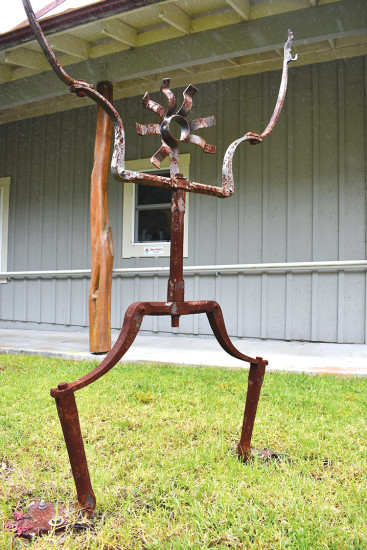
Currently growing among the sculptures are 20 or so native plant species: a feast of shape and form as rich and varied as the art itself. They include plants from every level of the rainforest canopy, from trees and tree ferns to vines to understory shrubs to creeping ground cover plants. Some, such as ‘ōhi‘a lehua and hapu‘u pulu, are recognizable to most island residents, however some are well known only to botanists. The yellow-blossomed hau is quite beautiful, as is the silvery ‘olina and the pāwale, a small shrub with handsome red-brown stems and narrow, vibrantly green leaves. Other plants are a bit unusual. The pa‘iniu, for instance, vaguely resembles what might happen if a pineapple top got stretched out into a vine.
Right behind the garden, a small wooden gate leads to a nature trail that winds through one of the few remaining truly old growth rainforests on Hawai‘i Island. Most of the island’s forests were logged off and regrown in the 19th or 20th centuries, so the trees there are relatively young. The forest along the path, however, is so ancient that some giant ‘ōhi‘a grow amidst a network of arboreal flying buttresses: their main trunks begin five feet off the ground because as saplings, they grew atop the fallen trunks of other giants that have since rotted away, and the current giants now have other trees growing from their branches.
The sculpture garden and the forest path complement each other. Everything in the garden is inspired by nature; even the placement of rocks is deliberately planned to look random and natural. Just beyond the gate of the garden lives the inspiration itself, and they interact: seeds and spores and even wildlife from the forest are starting to shape the garden, adding their own elements to the human design. A volunteer koa sapling sprouts along the garden path. A native moth flits on mottled grey-and-brown wings out of the forest; moving, it’s strikingly visible, but when it settles on the bark of a young ‘ōhi‘a, its wing markings become camouflage, causing it to disappear. Small shiny black skinks, the color of pahoehoe (smooth lava), sun themselves on those carefully placed stones. Nature fosters art, and art fosters nature.
Like nature, the garden will continue to grow. The Hawai‘i State Foundation on Culture will be loaning Volcano Art Center three sculptures from the Foundation’s collection. The current exhibition will continue until September; the one that follows will open in March 2019 and will be even more ambitious. Called “Interplay: Art/Science,” and curated by University of Hawai‘i at Hilo Art Department Chair Michael Marshall, the new show will be open to artists across the state. According to Elizabeth, the new show will feature art that “takes something in nature or a scientific or mathematical principle and expresses it as an art form.” Artists interested in participating can contact Volcano Art Center or submit their sculpture ideas at callforentry.org. ❖
For more information: VolcanoArtCenter.org
